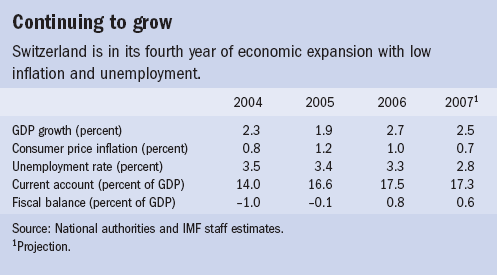
Typical street scene in Santa Ana, El Salvador. (Photo: iStock)
IMF Survey: Swiss Aim for Consensus on Reforms
July 18, 2007
- Swiss economic performance is good, with above-trend growth, low inflation
- Country must address shrinking workforce, rising costs of aging population
- Authorities trying to build consensus for reform among voters
The Swiss economy is performing well. It grew by 2.7 percent in 2006—far above trend—and unemployment fell to 3 percent.

Cattle farm in Berne canton, Switzerland—where sheltered agricultural sector helps keep price level high (photo: KPA/Mediacolors)
COSTS OF AGING POPULATION
Inflation was only 1 percent (see table) because an inflow of workers from the European Union (EU) and tighter competition in retail markets kept wages and prices in check.

In addition, strong growth in exports and high earnings on Swiss residents' large investments abroad have more than doubled the current account surplus since 2002. On the fiscal front, the debt brake rule, designed to contain expenditures, combined with buoyant cyclical revenue to produce a surplus one year ahead of schedule.
Switzerland's medium-term prospects also appear bright. Growth in 2007 is projected to be about 2½ percent, with continued gains in employment and inflation of less than 1 percent.
Decline in labor force
Maintaining this good performance, however, will require that the authorities tackle some critical challenges. For example, unless productivity improves, a decline in the labor force is projected to lower potential output growth to 1¼ percent over a decade.
At the same time, some domestic sectors—among them agriculture and network industries such as gas and electricity—remain sheltered, helping to keep the Swiss price level high. For the Swiss retail industry, gross production costs are, on average, 23 percent higher than for retailers in Austria, France, Germany, and Italy. In addition, spending on entitlements, such as pensions, continues to expand as the population ages.
Although the current debt brake fiscal framework is highly valuable as a cyclical tool, it is not designed to withstand structural fiscal pressures from population aging—indicating that alternative long-term solutions to these fiscal pressures need to be found. The financial sector plays a key role in Switzerland's economic performance and in the international financial system. This sector is sophisticated and is developing new markets, such as exotic derivatives instruments and lending to hedge funds and other highly leveraged firms. These activities are a challenge for a relatively small home country to supervise.
Swiss voters recently rejected proposals for a value-added tax and for health care reform that the government believes are needed to improve economic performance. The authorities are aware of the need to establish a consensus for these changes, and public debate about needed reforms is creating a basis for further progress.
Swiss authorities are acting in a number of areas:
• Raising potential growth. The authorities are implementing a package of measures that include revising Swiss law to eliminate obstacles to a more unified internal market, and reducing technical barriers to imports by accepting products conforming to EU standards. They are also preparing agricultural policy reforms, to take effect by 2011. Studies commissioned by the government have shown that reforms in network industries and a reduction in import barriers and deregulation could increase output by 10 billion Swiss francs (2 percent of GDP) and reduce the price level by 15 percentage points if fully implemented.
• Strengthening fiscal sustainability. The government has made substantial discretionary cuts, but also has placed expenditures off budget to reach its fiscal targets under the debt brake and must find compensating revenues or spending cuts to put them back on budget. One key priority is to develop a strategy to close the long-run fiscal gap. A number of tax, pension and disability, health care, and other entitlement reform proposals are under consideration to help close the shortfall. The authorities have conducted a study on essential government tasks and subsidies that suggests ways to produce savings of 0.6 percent of GDP over 2008-10. Also, to communicate the need for further reforms, they are preparing a long-run fiscal sustainability report that will lay out the fiscal challenges of population aging and assess possible measures.
• Improving financial sector supervision. A recent IMF Financial Sector Assessment Program update mission found the Swiss financial system resilient to shocks, although it identified some areas for policy attention. In particular, it stressed that the new Financial Market Supervisory Authority should have financial and regulatory independence and adequate human capital resources, as well as sanctioning power. It also noted that whereas implementation of the Basel II recommendation on capital adequacy, which seeks to promote a healthy cushion of capital in banks, is far advanced, liquidity management and supervision also need to be strengthened in line with Bank for International Settlements standards. The IMF mission said it was pleased that the authorities are building close relationships with foreign supervisory and regulatory agencies, given the global involvement of the large Swiss banks. The mission concluded, however, that pension supervision remains fragmented and uneven among cantons, and some underfunding problems need to be resolved.







